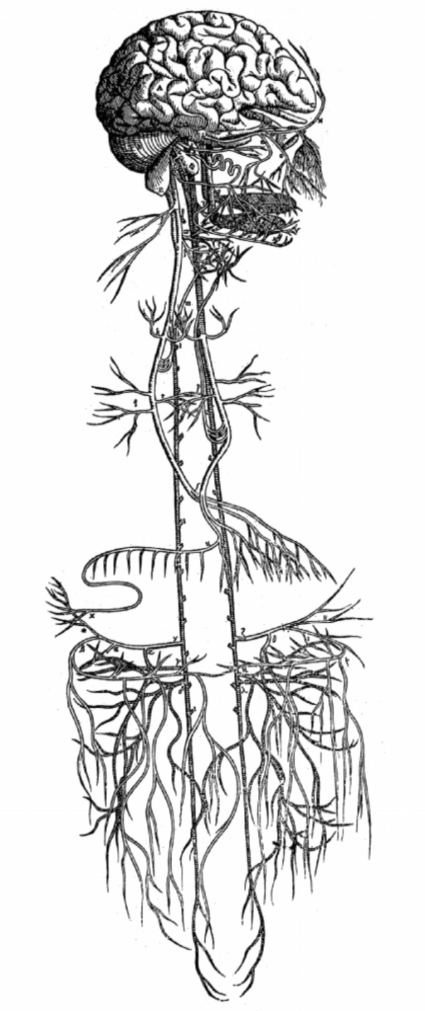vagus clinic
Vagus Nerve
vagus clinic
The Vagus nerve is the tenth cranial nerve and is otherwise known as the “wandering nerve”. It is of great significance in our bodies as it innervates most of our gut and numerous other organs including your heart. It can be a big part of many diseases, and when I was not well, this was one of the major nerves with dysfunction.
- Dr. Stephanie Canestraro
The vagus nerve is the cranial nerve X (CNX) or your tenth cranial nerve. It is also known as the "wandering nerve" because it is the longest parasympathetic nerve in the body! It has been compared to the conductor of the orchestra because it takes the lead in almost every autonomic function in the body. Science has confirmed that the vagus nerve is the key to wellness as it stimulates the "rest and digest" side of our nervous system, as opposed to the sympathetic "fight or flight" side of the nervous system.
The vagus nerve has two branches: the ventral vagus nerve and the dorsal vagus nerve, which are named because of where they originate from on the brainstem. The anterior vagal branch innervates the organs above the diaphragm, the heart and lungs, the back of the soft palate, some skin over the tragus of your ear, and more. The dorsal branch mainly innervates the organs below the diaphragm, including: the kidneys, liver, gallbladder, and the gut all the way down to the transverse colon.
The vagus nerve acts like an information highway straight to your brain, and when our vagus nerve is not firing well, it’s called "low vagal tone". Low vagal tone has been associated with IBS, rheumatoid arthritis, anxiety and panic attacks, and poor heart rate variability. Training your vagus nerve can help increase overall well being!
This nerve is so amazing and that is why Dr. Stephanie Canestraro named the clinic after it. Not only is she a travelling or "wandering" doctor, but she also was really ill in her childhood and early 20’s, and fixing her vagus nerve was key to her healing! Now, she uses the vagus nerve and the gut-brain connection to help out all her patients and improve not only brain and gut health, but health overall.
How to train your vagus nerve or increase vagal tone
1. Gazing exercise
While laying down, interlock your fingers and place your hands behind your head. Allow your head to rest in your hands. Gently gaze your eyes as far to the right as you can without straining hold, until you feel a sense of calm or the need to sigh. Now repeat on the left side. This helps activates your vagus nerve by stretching the common fascia in the brain to the back of the head.
2. Gargling/humming/singing/GAG REFLEX
The vagus nerve innervates the soft tissue in the back of the palate (back of throat), so making noises with your throat like "ah ah ah ah" or humming, or making an "ommmm" sound helps turn it on.
Gag reflex is powerful, albeit a little less pleasant. You can use the back of your toothbrush or a tongue depressor, or even a Q-tip and touch the back of your throat gently in order to activate the vagus nerve!
3. HEART RATE VARIABILITY
The anterior branch of the vagus nerve innervates the heart, and HRV is a great way to practice improving your vagal tone! A tool that I use is called "Inner Peace" by Heart Math and you can use it as biofeedback to measure the variability in your heart rate. The Inner Balance App uses an ear sensor to capture your Heart-Rate Variability (HRV) data. This data gives the most accurate, in-the-moment reading of your heart-rhythm patterns, and coaches you with breathing patterns to improve your HRV.
4. Deep breathing/ meditation
You breathe in for 5-6 seconds, then hold 5 seconds, then breathe out for a count of 6-7 seconds. Do this 10 times!
5. Cold water
Taking cold showers, splashing cold water on your face, or placing anything cold on your face. Exposing your body to acute cold conditions such as taking a cold shower or splashing cold water on your face, increases stimulation of the vagus nerve. While your body adjusts to the cold, sympathetic activity declines, while parasympathetic activity increases.
6. Acupuncture
Acupuncture or pseudo-acupuncture using a toothpick. The vagus nerve innervates your tragus, auricle and skin over the inner canal of your ear. You can tap a toothpick over this area, and this can stimulate your vagus nerve.
7. Fasting
The vagus nerve is the director of the parasympathetic nervous system known as the "rest and digest" system. Giving the digestion process a break through intermittent fasting, or less snacks throughout the day will also improve vagal tone.
8. Tickling face and neck/ Scalp massage
Tickling the face and neck, or a scalp massage, affects the nerves that come off the same area of the brain that the vagus nerve innervates. These areas when stimulated, causes relaxation and increases vagal tone!
9. BINAURAL BEATS
Your left and right brain can begin to connect and cross-communicate harmoniously by using binaural frequencies. The binaural beats stimulate the vagus nerve with the ultimate goal of helping carry you into a state of deep relaxation, necessary for a healthier body and longer life.
10. VAGUS CODE
We strongly believe that staying active through an exercise training program, healing your gut, and certain supplements will also have huge benefits for your vagus nerve.



